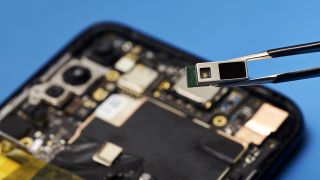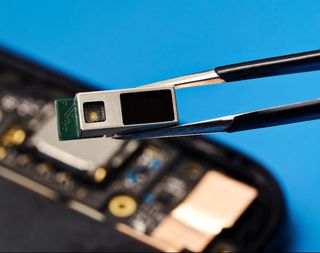100x Faster Than Wi-Fi: Li-Fi, Light-Based Networking Standard Released
Proponents boast that 802.11bb is 100 times faster than Wi-Fi and more secure.

Today, the Institute of Electrical and Electronics Engineers (IEEE) has added 802.11bb as a standard for light-based wireless communications. The publishing of the standard has been welcomed by global Li-Fi businesses, as it will help speed the rollout and adoption of the data-transmission technology standard.
Advantages of using light rather than radio frequencies (RF) are highlighted by Li-Fi proponents including pureLiFi, Fraunhofer HHI, and the Light Communications 802.11bb Task Group. Li-Fi is said to deliver “faster, more reliable wireless communications with unparalleled security compared to conventional technologies such as Wi-Fi and 5G.” Now that the IEEE 802.11bb Li-Fi standard has been released, it is hoped that interoperability between Li-Fi systems with the successful Wi-Fi will be fully addressed.
Of course, Li-Fi isn’t going to sweep away Wi-Fi and 5G alternatives (nor wired networks). Radio waves still have a distinct advantage with regard to transmission through the atmosphere at great distance, and though opaque objects. Instead, work must concentrate on using horses for courses – with Li-Fi advantages being harvested where possible.
In the Fraunhofer HHI video above you can see a Li-Fi system re-using a building’s lighting infrastructure for data. Don’t worry, the lights don’t visibly blink or flash, as the data transmission uses part of the infrared spectrum.
Where Li-Fi shines (pun intended) is not just in its purported speeds as fast as 224 GB/s. Fraunhofer’s Dominic Schulz points out that as it works in an exclusive optical spectrum, this ensures higher reliability and lower latency and jitter. Moreover “Light’s line-of-sight propagation enhances security by preventing wall penetration, reducing jamming and eavesdropping risks, and enabling centimetre-precision indoor navigation,” says Shultz.

Now the IEEE 802.11bb standard is published, manufacturers can have greater confidence in the ecosystem and start integrating the tech, where suitable. One of the big wheels of Li-Fi, pureLiFi, has already prepared the Light Antenna ONE module for integration into connected devices. This 14.5mm long component (pictured above and top) is currently being provided to OEMs for evaluation. In its promotional materials the firm suggests that Li-Fi is preferable over Wi-Fi for: more connections without congestion, greater security and privacy, and doing the heavy lifting for the highest bandwidth tasks.
We expect to see a far fuller gamut of Li-Fi network devices, and user devices which support the standard, emerge between now and MWC next February.
Stay On the Cutting Edge: Get the Tom's Hardware Newsletter
Get Tom's Hardware's best news and in-depth reviews, straight to your inbox.

Mark Tyson is a news editor at Tom's Hardware. He enjoys covering the full breadth of PC tech; from business and semiconductor design to products approaching the edge of reason.
-
peachpuff Show me some demos of this, if i have to hold my phone a certain way or be in a certain spot or not move to keep a connection or have exposed bulbs in my room this will be a deal breaker.Reply -
bill001g It also gets into the question of why bother. You do not really need super fast speeds to a device like a cell phone or pad device you will just fill the storage quicker. Its not like you are downloading microsoft flight simulator to a phone.Reply
If it is a desktop computer and it must be in the same room as the router you might as well run a ethernet cable and avoid the complexity.
Only thing I could see is maybe vr units so you could have only the display in the headset to cut the weight. -
annymmo Seems very interesting for streaming video to (and from) wireless AR/VR/MR/XR/etc. headsets.Reply -
LuxZg Replyannymmo said:Seems very interesting for streaming video to (and from) wireless AR/VR/MR/XR/etc. headsets.
It would be, but only if you retain full freedom of movement inside the VR space. If it loses connection when I rotate my head it's useless. Yet article said nothing about restrictions... and I have a bad feeling there are plenty of them -
MiniITXEconomy Pipggybacking off of your existing electrical grid sounds nice, but I imagine that means the end of enclosed fixtures inside your home if you plan to adopt this, properly, and always having the lights on inside your home office sounds like a major hassle. Imagine sitting at your desk, with the dimmer switch for your bare overhead light set to maximum, because you need all that bandwidth...Reply
But I feel like I'm not seeing the bigger picture. Could my PS5 beam it's image to my TV using this tech, nixing any need for an HDMI cable? Couldn't you theoretically attach a WIFI router to a LIFI sensor, thereby creating your own centralized bedroom network? And what about homes with poor wiring? Hell, I can't run my vacuum inside my game room without the lights in my bathroom flickering.
May seem like basic questions, but this is my first day hearing about LIFI. I gotta say, I like what I'm hearing, though. -
PEJUman light is just visible RF.... recall 60 GHz nearfield wifi? Intel AD/HTC vive wiress devices anyone? aka WiGig.Reply
very high bandwidth, can barely pass paper/carboard obstacles?
Visible wavelength range is 400 ~ 770K Ghz, aka 400~770 Thz. Talk about line of sight & stuff better be transparent in-between the devices (like smoke/suspended particles/humidity/etc). -
pixelpusher220 Reply
Home based may not be the real use case. The significant bandwidth increase seems tailor made for commercial applications. Another ceiling fixture there isn't a big deal. Especially indoor stadiums, tho perhaps range would be an issue.MiniITXEconomy said:Pipggybacking off of your existing electrical grid sounds nice, but I imagine that means the end of enclosed fixtures inside your home if you plan to adopt this, properly, and always having the lights on inside your home office sounds like a major hassle. Imagine sitting at your desk, with the dimmer switch for your bare overhead light set to maximum, because you need all that bandwidth...
But I feel like I'm not seeing the bigger picture. Could my PS5 beam it's image to my TV using this tech, nixing any need for an HDMI cable? Couldn't you theoretically attach a WIFI router to a LIFI sensor, thereby creating your own centralized bedroom network? And what about homes with poor wiring? Hell, I can't run my vacuum inside my game room without the lights in my bathroom flickering.
May seem like basic questions, but this is my first day hearing about LIFI. I gotta say, I like what I'm hearing, though.
Line of site req's make mobile devices that can't have an omni directional antenna might be problematic. if the wrong side of a phone is down it can't connect -
Thunder64 Did anybody read the article? It uses IR, not visible light. You won't have to light up your house to use it. Also, this isn't for residental use or connecting cell phones, etc.Reply
I see it as an alternative to wired for long distance that are within line of sight. You would have a huge bandwidth link between those devices which would then use traditional WiFi to connect to devices nearby. -
YSCCC needing to use a flashing light source and reciever sounds like wireless optical fibre.. but without the fibre you need to have a strong light flashing constantly into an area and the client end need to flash back to communicate, I can't really percieve this to be useful outside of say, commercial storage server for hot swarpping drives. for civilian use having a overhead light keep shining and my phone/computer shine back don't seem like a good idea for eye fatigue or light pollutionReply
Most Popular







